Groundwater Extraction Reduction within an Irrigation District by Enhancing the Surface Water Distribution
Abstract
:1. Introduction
2. Materials and Methods
2.1. Study Area
2.2. Simulation of Surface Water Distribution Management
2.2.1. Performance Evaluation Indices
2.2.2. Aquifer Balancing Strategies
2.2.3. Hydro-Mechanical Operating System
2.2.4. Manual-Based Operating System
2.2.5. Centralized Automatic Operating System
2.3. Numerical Modeling of the Groundwater
2.4. Drought Scenarios
3. Results
3.1. Adequacy and Dependability Indices of Agricultural Water Distribution in the Normal Scenario
3.1.1. Adequacy and Dependability Indices of Agricultural Water Distribution in the 15% Drought Scenario
3.1.2. Adequacy and Dependability Indices of Agricultural Water Distribution in the 30% Drought Scenario
3.2. Numerical Modeling of Groundwater
3.2.1. Aquifer Situation in the Next Five Years Due to the Normal Scenario
3.2.2. Aquifer Situation in the Next Five Years Due to the 15% Drought Scenario
3.2.3. Aquifer Situation in the Next Five Years Due to the 30% Drought Scenario
4. Discussion
5. Conclusions
Author Contributions
Funding
Institutional Review Board Statement
Informed Consent Statement
Data Availability Statement
Acknowledgments
Conflicts of Interest
References
- Vörösmarty, C.J.; McIntyre, P.B.; Gessner, M.O.; Dudgeon, D.; Prusevich, A.; Green, P.; Liermann, C.R. Global threats to human water security and river biodiversity. Nature 2010, 467, 555–561. [Google Scholar] [CrossRef]
- Alcamo, J.; Henrichs, T.; Rösch, T. World Water in 2025—Global Modeling and Scenario Analysis for the World Commission on Water for the 21st Century; Kassel World Water Series 2; Center for Environmental Systems Research, University of Kassel: Kassel, Germany, 2000. [Google Scholar]
- Kahil, M.T.; Dinar, A.; Albiac, J. Modeling water scarcity and droughts for policy adaptation to climate change in arid and semi-arid regions. J. Hydrol. 2015, 522, 95–109. [Google Scholar] [CrossRef] [Green Version]
- MacDonald, A.M.; Bonsor, H.C.; Dochartaigh, B.E.O.; Taylor, R.G. Quantitative maps of groundwater resources in Africa. Environ. Res. Lett. 2012, 7, 024009. [Google Scholar] [CrossRef]
- Kourakos, G.; Dahlke, H.E.; Harter, T. Increasing groundwater availability and seasonal base flow through agricultural managed aquifer recharge in an irrigated basin. Water Resour. Res. 2019, 55, 7464–7492. [Google Scholar] [CrossRef] [Green Version]
- Villholth, K.; Giordano, M. Groundwater use in a global perspective–can it be managed. Agric. Groundw. Revolut. Oppor. Threat. Dev. 2007, 3, 393–402. [Google Scholar]
- Perkin, J.S.; Gido, K.B.; Falke, J.A.; Fausch, K.D.; Crockett, H.; Johnson, E.R.; Sanderson, J. Groundwater declines are linked to changes in Great Plains stream fish assemblages. Proc. Natl. Acad. Sci. USA 2017, 114, 7373–7378. [Google Scholar] [CrossRef] [PubMed] [Green Version]
- Agoubi, B.; Kharroubi, A.; Abida, H. Saltwater intrusion modelling in Jorf coastal aquifer, South-eastern Tunisia: Geochemical, geoelectrical and geostatistical application. Hydrol. Processes 2013, 27, 1191–1199. [Google Scholar] [CrossRef]
- Erler, A.R.; Frey, S.K.; Khader, O.; d’Orgeville, M.; Park, Y.J.; Hwang, H.T.; Lapen, D.R.; Peltier, W.R.; Sudicky, E.A. Evaluating climate change impacts on soil moisture and groundwater resources within a lake-affected region. Water Resour. Res. 2019, 55, 8142–8163. [Google Scholar] [CrossRef]
- Taylor, R.G.; Scanlon, B.; Döll, P.; Rodell, M.; Van Beek, R.; Wada, Y.; Longuevergne, L.; Leblanc, M.; Famiglietti, J.S.; Edmunds, M.; et al. Ground water and climate change. Nat. Clim. Chang. 2013, 3, 322–329. [Google Scholar] [CrossRef] [Green Version]
- Wada, Y.; Wisser, D.; Bierkens, M.F. Global modeling of withdrawal, allocation and consumptive use of surface water and groundwater resources. Earth Syst. Dyn. 2014, 5, 15–40. [Google Scholar] [CrossRef] [Green Version]
- Ashraf, B.; AghaKouchak, A.; Alizadeh, A.; Mousavi Baygi, M.; Moftakhari, H.R.; Mirchi, A.; Anjileli, H.; Madani, K. Quantifying anthropogenic stress on groundwater resources. Sci. Rep. 2017, 7, 1–9. [Google Scholar] [CrossRef] [Green Version]
- Joodaki, G.; Wahr, J.; Swenson, S. Estimating the human contribution to groundwater depletion in the Middle East, from GRACE data, land surface models, and well observations. Water Resour. Res. 2014, 50, 2679–2692. [Google Scholar] [CrossRef]
- Voss, K.A.; Famiglietti, J.S.; Lo, M.; De Linage, C.; Rodell, M.; Swenson, S.C. Groundwater depletion in the Middle East from GRACE with implications for transboundary water management in the Tigris-Euphrates-Western Iran region. Water Resour. Res. 2013, 49, 904–914. [Google Scholar] [CrossRef] [Green Version]
- Prasad, Y.S.; Rao, B.V. Groundwater depletion and groundwater balance studies of Kandivalasa river sub basin, Vizianagaram district, Andhra Pradesh, India. Groundw. Sustain. Dev. 2018, 6, 71–78. [Google Scholar] [CrossRef]
- Suter, J.F.; Rad, M.R.; Manning, D.T.; Goemans, C.; Sanderson, M.R. Depletion, climate, and the incremental value of groundwater. Resour. Energy Econ. 2019, 63, 101143. [Google Scholar] [CrossRef]
- Gleeson, T.; Wada, Y.; Bierkens, M.F.; Van Beek, L.P. Water balance of global aquifers revealed by groundwater footprint. Nature 2012, 488, 197–200. [Google Scholar] [CrossRef]
- Zektser, I.S.; Everett, L.G. Groundwater Resources of the World and Their Use; Groundw. No 6; UNESCO: Paris, France, 2004; Available online: http://unesdoc.unesco.org/images/0013/001344/134433e.pdf (accessed on 9 April 2010).
- Scanlon, B.R.; Faunt, C.C.; Longuevergne, L.; Reedy, R.C.; Alley, W.M.; McGuire, V.L.; McMahon, P.B. Groundwater depletion and sustainability of irrigation in the US High Plains and Central Valley. Proc. Natl. Acad. Sci. USA 2012, 109, 9320–9325. [Google Scholar] [CrossRef] [Green Version]
- De Graaf, I.E.; Gleeson, T.; Van Beek, L.R.; Sutanudjaja, E.H.; Bierkens, M.F. Environmental flow limits to global groundwater pumping. Nature 2019, 574, 90–94. [Google Scholar] [CrossRef]
- Serra, P.; Salvati, L.; Queralt, E.; Pin, C.; Gonzalez, O.; Pons, X. Estimating water consumption and irrigation requirements in a long-established mediterranean rural community by remote sensing and field data. Irrig. Drain. 2016, 65, 578–588. [Google Scholar] [CrossRef]
- Shahdany, S.H.; Majd, E.A.; Firoozfar, A.; Maestre, J. Improving operation of a main irrigation canal suffering from inflow fluctuation within a centralized model predictive control system: Case study of Roodasht Canal, Iran. J. Irrig. Drain. Eng. 2016, 142, 05016007. [Google Scholar] [CrossRef]
- Abbasi, F.; Sohrab, F.; Abbasi, N. Evaluation of irrigation efficiencies in Iran. Irrig. Drain. Struct. Eng. Res. 2017, 17, 113–120. [Google Scholar]
- Agide, Z.; Haileslassie, A.; Sally, H.; Erkossa, T.; Schmitter, P.S.; Langan, S.J.; Hoekstra, D. Analysis of Water Delivery Performance of Smallholder Irrigation Schemes in Ethiopia: Diversity and Lessons across Schemes, Typologies and Reaches; International Livestock Research Institute: Nairobi, Kenya, 2016. [Google Scholar]
- Barkhordari, S.; Shahadany, S.H.; Taghvaeian, S.; Firoozfar, A.R.; Maestre, J.M. Reducing losses in earthen agricultural water conveyance and distribution systems by employing automatic control systems. Comput. Electron. Agric. 2020, 168, 105122. [Google Scholar] [CrossRef]
- Guan, G.; Clemmens, A.; Kacerek, T.; Wahlin, B. Applying water-level difference control to central Arizona project. J. Irrig. Drain. Eng. 2011, 137, 747–753. [Google Scholar] [CrossRef]
- Yang, Z.; Mao, Z.; Guan, G.; Gao, W. Space-time mesh refinement method for simulating transient mixed flows. J. Hydraul. Res. 2021, 59, 835–846. [Google Scholar] [CrossRef]
- Zhong, K.; Guan, G.; Tian, X.; Maestre, J.M.; Mao, Z. Evaluating optimization objectives in linear quadratic control applied to open canal automation. J. Water Resour. Plan. Manag. 2020, 146, 04020087. [Google Scholar] [CrossRef]
- Zhonghao, M.; Guanghua, G.; Zhonghua, Y.; Ke, Z. Linear model of water movements for large-scale inverted siphon in water distribution system. J. Hydroinformatics 2019, 21, 1048–1063. [Google Scholar] [CrossRef] [Green Version]
- Liu, G.; Guan, G.; Wang, C. Transition mode of long distance water delivery project before freezing in winter. J. Hydroinformatics 2013, 15, 306–320. [Google Scholar] [CrossRef]
- Savari, H.; Monem, M.; Shahverdi, K. Comparing the Performance of FSL and Traditional Operation Methods for On-Request Water Delivery in the Aghili Network, Iran. J. Irrig. Drain. Eng. 2016, 142, 04016055. [Google Scholar] [CrossRef]
- Shahverdi, K.; Monem, M.J. Application of reinforcement learning algorithm for automation of canal structures. Irrig. Drain. 2015, 64, 77–84. [Google Scholar] [CrossRef]
- Shahverdi, K.; Monem, M.J.; Nili, M. Fuzzy SARSA learning of operational instructions to schedule water distribution and delivery. Irrig. Drain. 2016, 65, 276–284. [Google Scholar] [CrossRef]
- Omidzade, F.; Ghodousi, H.; Shahverdi, K. Comparing fuzzy SARSA learning and ant Colony optimization algorithms in water delivery scheduling under water shortage conditions. J. Irrig. Drain. Eng. 2020, 146, 04020028. [Google Scholar] [CrossRef]
- Shahverdi, K.; Maestre, J.; Alamiyan-Harandi, F.; Tian, X. Generalizing fuzzy SARSA learning for real-time operation of irrigation canals. Water 2020, 12, 2407. [Google Scholar] [CrossRef]
- Gleeson, T.; Richter, B. How much groundwater can we pump and protect environmental flows through time? Presumptive standards for conjunctive management of aquifers and rivers. River Res. Appl. 2018, 34, 83–92. [Google Scholar] [CrossRef]
- Salam, M.; Cheema, M.J.M.; Zhang, W.; Hussain, S.; Khan, A.; Bilal, M.; Arshad, A.; Ali, S.; Zaman, M.A. Groundwater storage change estimation using grace satellite data in Indus Basin. Big Data Water Resour. Eng. 2020, 1, 13–18. [Google Scholar] [CrossRef]
- Aslam, M.; Arshad, M.; Hussain, S.; Usman, M.; Zahid, M.B.; Sattar, J.; Arshad, A.; Iqbal, M.M.; Waqas, M.S. An integrated approach for estimation of van genuchten model parameters in undisturbed and unsaturated soils. Pak. J. Agri. Sci. 2021, 58, 1895–1901. [Google Scholar]
- Arshad, A.; Zhang, Z.; Zhang, W.; Dilawar, A. Mapping favorable groundwater potential recharge zones using a GIS-based analytical hierarchical process and probability frequency ratio model: A case study from an agro-urban region of Pakistan. Geosci. Front. 2020, 11, 1805–1819. [Google Scholar] [CrossRef]
- Ministry of Power. Water Resources Balances for Najafabad Aquifer Area; Iran Water Resource: Tehran, Iran, 2012.
- Litrico, X.; Fromion, V. Modeling and Control of Hydrosystems; Springer Science & Business Media: Berlin, Germany, 2009. [Google Scholar]
- Xu, M. Real-Time Control of Combined Water Quantity & Quality in Open Channels. Ph.D. Thesis, Delft University of Technology, Delft, The Netherlands, 2013. [Google Scholar]
- Schuurmans, J.; Clemmens, A.; Dijkstra, S.; Hof, A.; Brouwer, R. Modeling of irrigation and drainage canals for controller design. J. Irrig. Drain. Eng. 1999, 125, 338–344. [Google Scholar] [CrossRef] [Green Version]
- Negenborn, R.R.; Van Overloop, P.-J.; Keviczky, T.; De Schutter, B. Distributed model predictive control of irrigation canals. Netw. Heterog. Media 2009, 4, 359. [Google Scholar] [CrossRef]
- Van Overloop, P.; Clemmens, A.; Strand, R.; Wagemaker, R.; Bautista, E. Real-time implementation of model predictive control on Maricopa-Stanfield irrigation and drainage district’s WM canal. J. Irrig. Drain. Eng. 2010, 136, 747–756. [Google Scholar] [CrossRef]
- Molden, D.J.; Gates, T.K. Performance measures for evaluation of irrigation-water-delivery systems. J. Irrig. Drain. Eng. 1990, 116, 804–823. [Google Scholar] [CrossRef]
- Hosseini Jolfan, M.; Hashemy Shahdany, S.M.; Javadi, S.; Mallakpour, I.; Neshat, A. Effects of canal automation on reducing groundwater extraction within irrigation districts: Case study of Qazvin irrigation district. Irrig. Drain. 2020, 69, 11–24. [Google Scholar] [CrossRef]
- Khiabani, M.Y.; Shahadany, S.H.; Maestre, J.; Stepanian, R.; Mallakpour, I. Potential assessment of non-automatic and automatic modernization alternatives for the improvement of water distribution supplied by surface-water resources: A case study in Iran. Agric. Water Manag. 2020, 230, 105964. [Google Scholar] [CrossRef]
- Van Overloop, P.J. Model Predictive Control on Open Water Systems; Delft University of Technology: Delft, The Netherlands, 2006. [Google Scholar]
- Van Overloop, P.; Weijs, S.; Dijkstra, S. Multiple Model Predictive Control on a drainage canal system. Control Eng. Pract. 2008, 16, 531–540. [Google Scholar] [CrossRef]
- Harbaugh, A.; Banta, E.; Hill, M.; Macdonald, M. The US Geological Survey Modular Ground Water Models: User Guide to Modulization Concepts and the Groundwater Flow Process. US Geol. Surv Open-File Rep 2000–92, 2000. Available online: http://water.usgs.gov/nrp/gwsoftware/modflow2000/ofr00-92 (accessed on 9 April 2010).
- Lalehzari, R.; Tabatabaei, S.-H.; Kholghi, M. Simulation of nitrate transport and wastewater seepage in groundwater flow system. Int. J. Environ. Sci. Technol. 2013, 10, 1367–1376. [Google Scholar] [CrossRef] [Green Version]
- Mazza, R.; La Vigna, F.; Alimonti, C. Evaluating the available regional groundwater resources using the distributed hydrogeological budget. Water Resour. Manag. 2014, 28, 749–765. [Google Scholar] [CrossRef]
- Sheng, Z. An aquifer storage and recovery system with reclaimed wastewater to preserve native groundwater resources in El Paso, Texas. J. Environ. Manag. 2005, 75, 367–377. [Google Scholar] [CrossRef]
- Anan, M.; Yuge, K.; Nakano, Y.; Saptomo, S.; Haraguchi, T. Quantification of the effect of rice paddy area changes on recharging groundwater. Paddy Water Environ. 2007, 5, 41–47. [Google Scholar] [CrossRef]
- Dillon, P.; Arshad, M. Managed aquifer recharge in integrated water resource management. In Integrated Groundwater Management; Springer: Cham, Switzerland, 2016; pp. 435–452. [Google Scholar]
- Jeong, H.Y.; Jun, S.-C.; Cheon, J.-Y.; Park, M. A review on clogging mechanisms and managements in aquifer storage and recovery (ASR) applications. Geosci. J. 2018, 22, 667–679. [Google Scholar] [CrossRef]
- Gibson, M.T.; Campana, M.E.; Nazy, D. Estimating aquifer storage and recovery (ASR) regional and local suitability: A case study in Washington state, USA. Hydrology 2018, 5, 7. [Google Scholar] [CrossRef] [Green Version]
- Javadi, S.; Saatsaz, M.; Shahdany, S.M.; Neshat, A.; Milan, S.G.; Akbari, S. A new hybrid framework of site selection for groundwater recharge. Geoscience Frontiers. 2021, 12, 101144. [Google Scholar] [CrossRef]
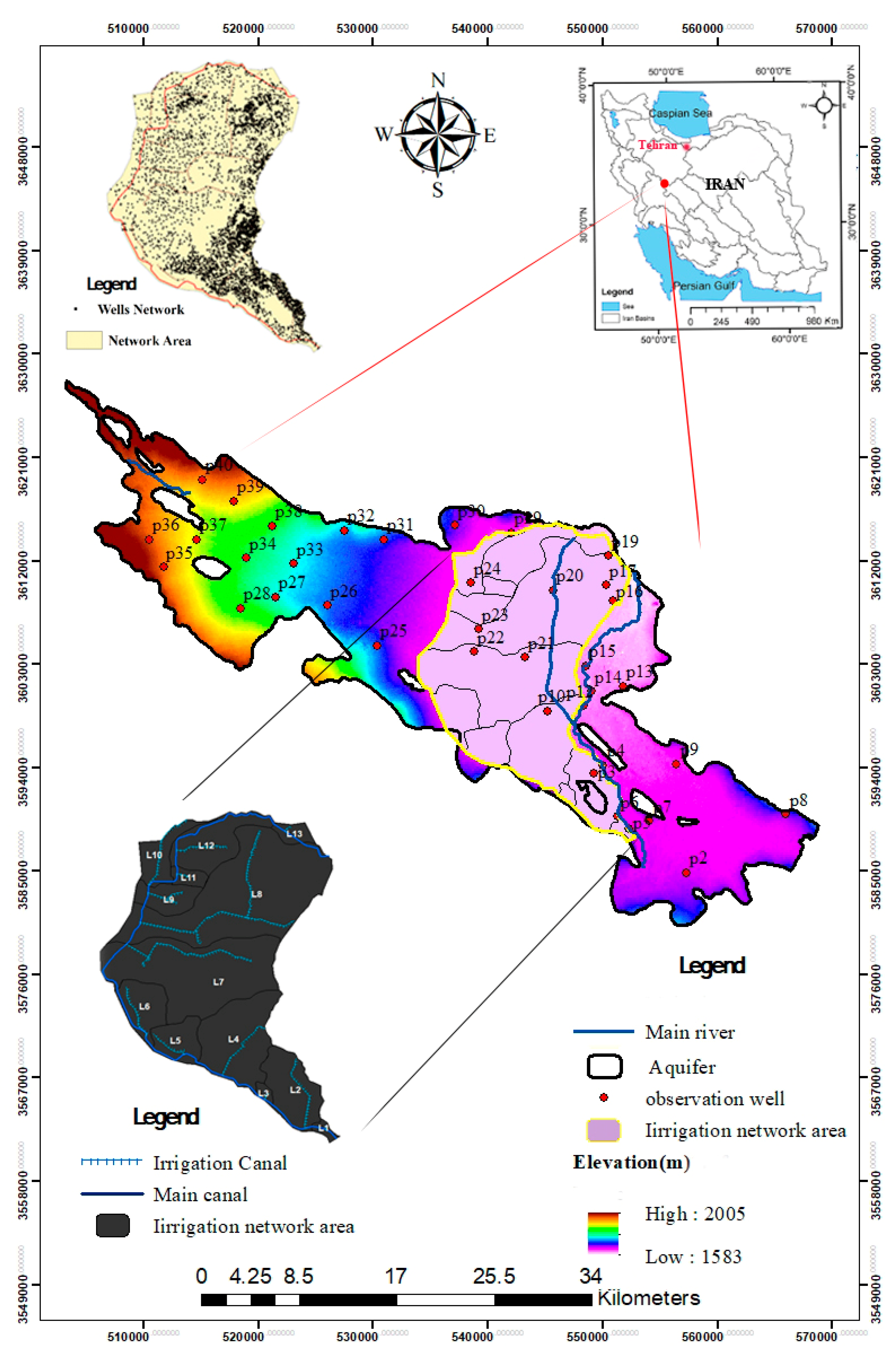
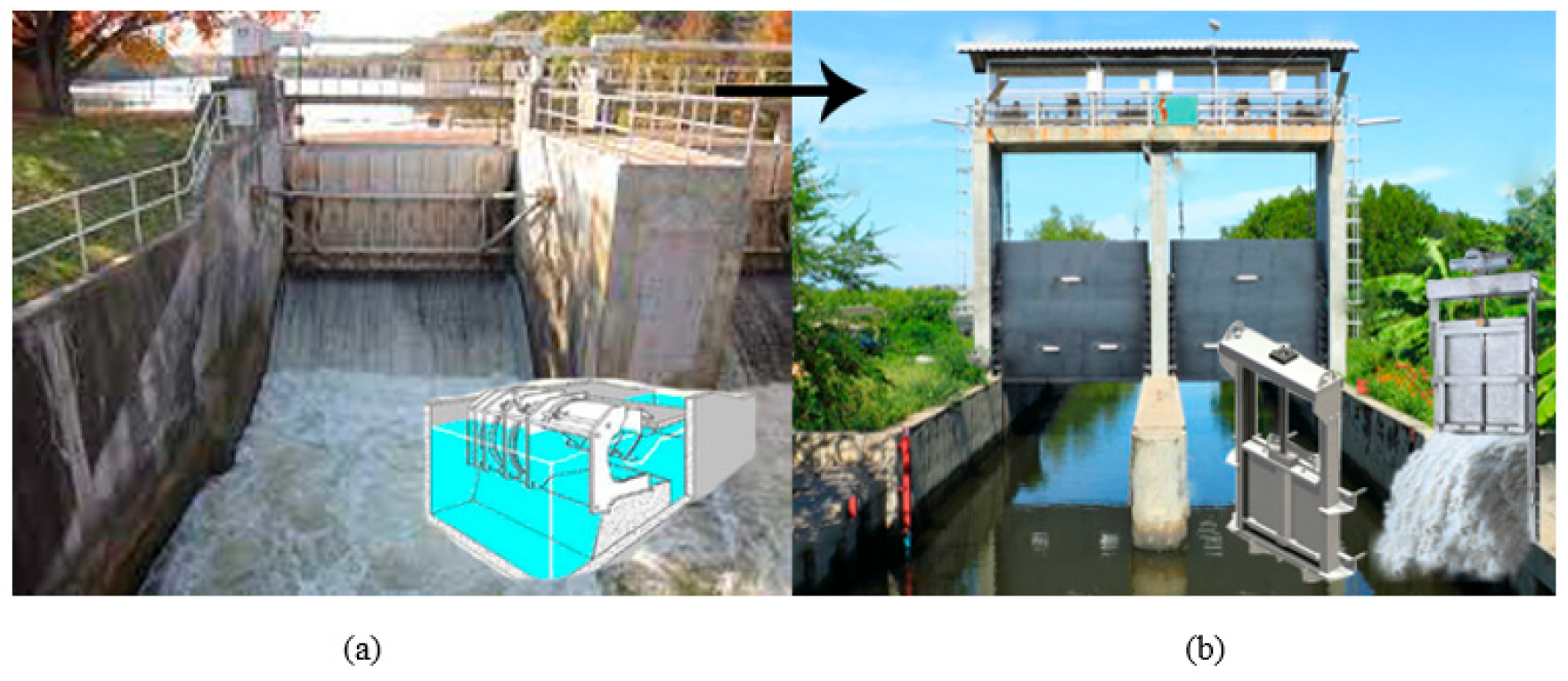
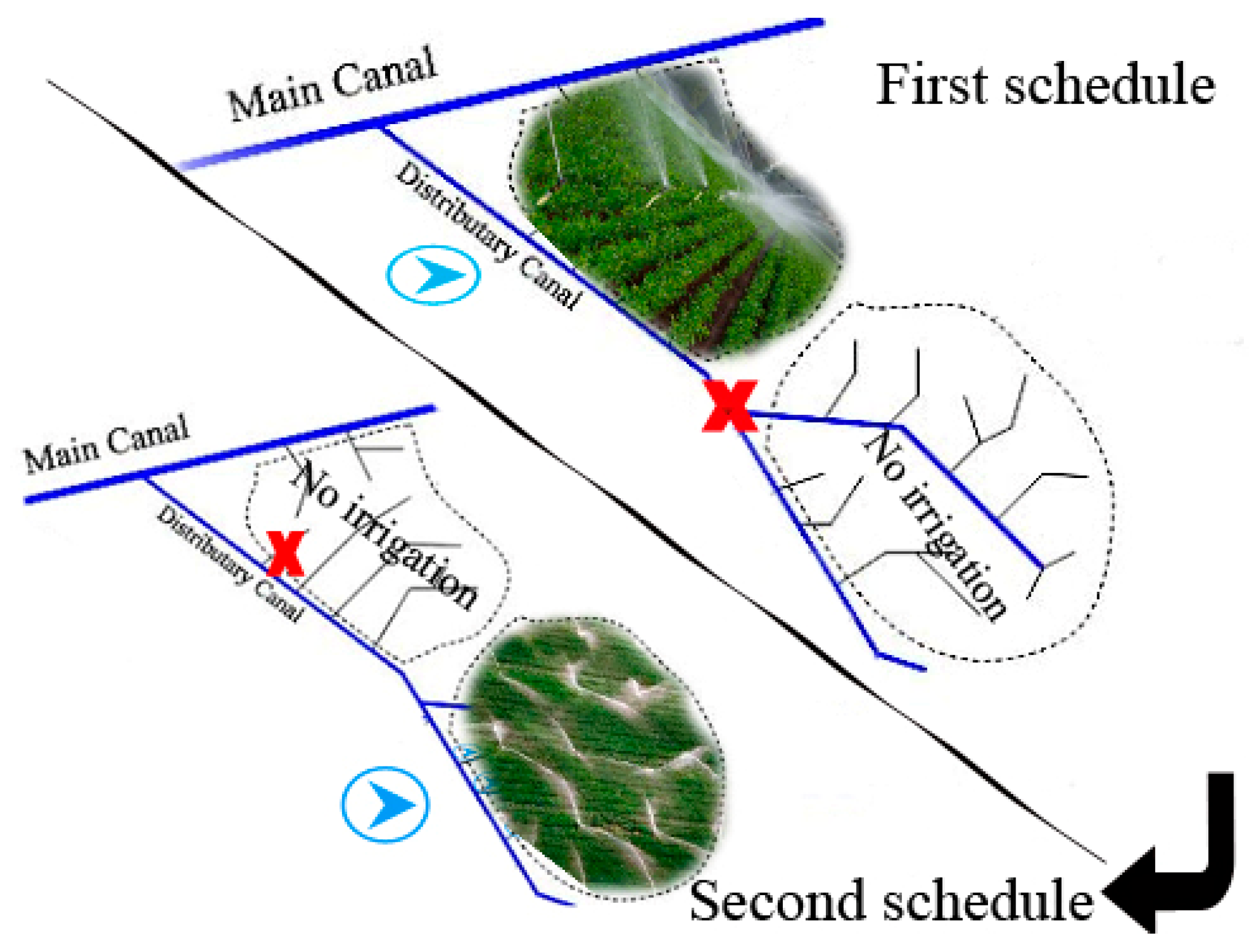
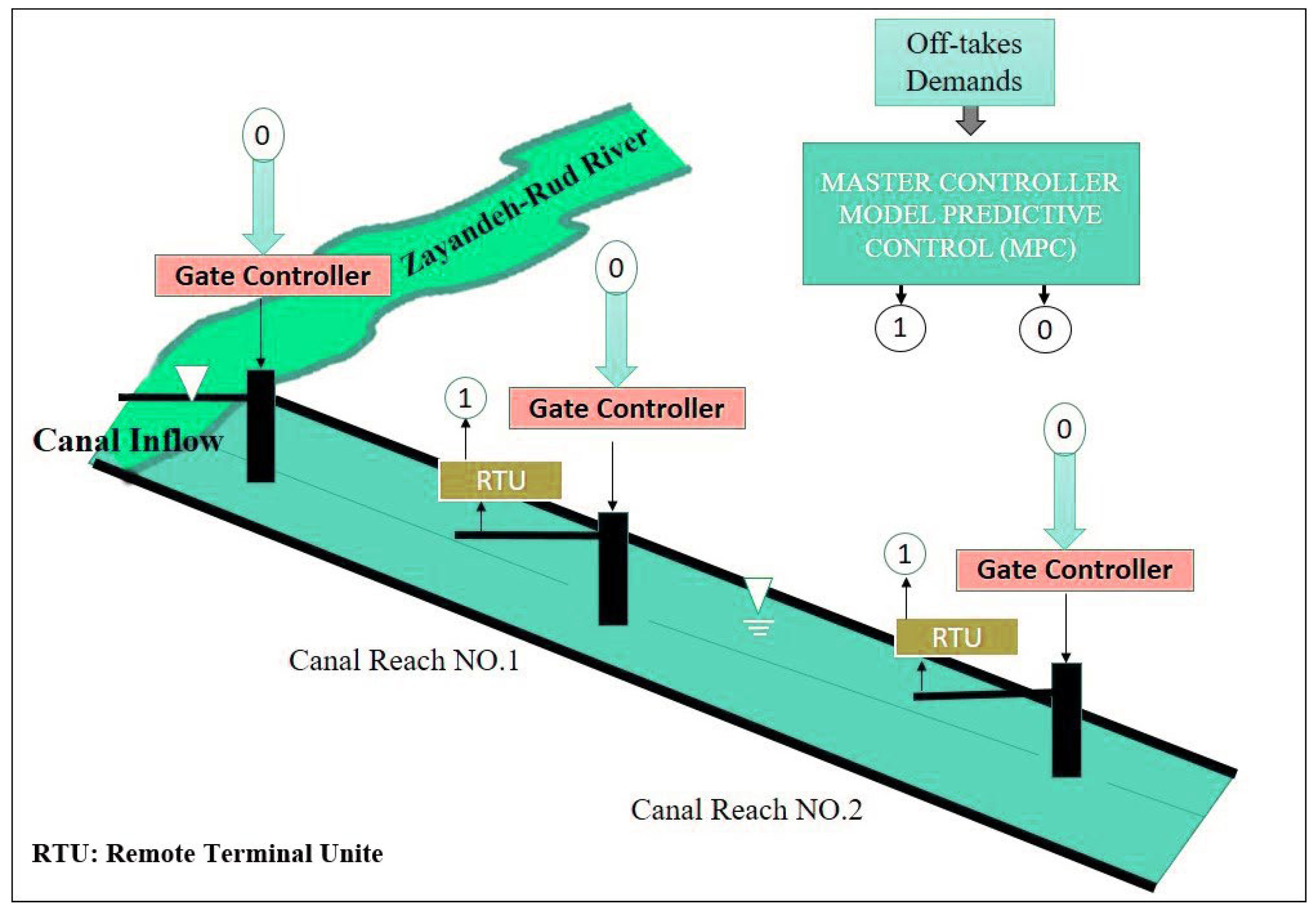
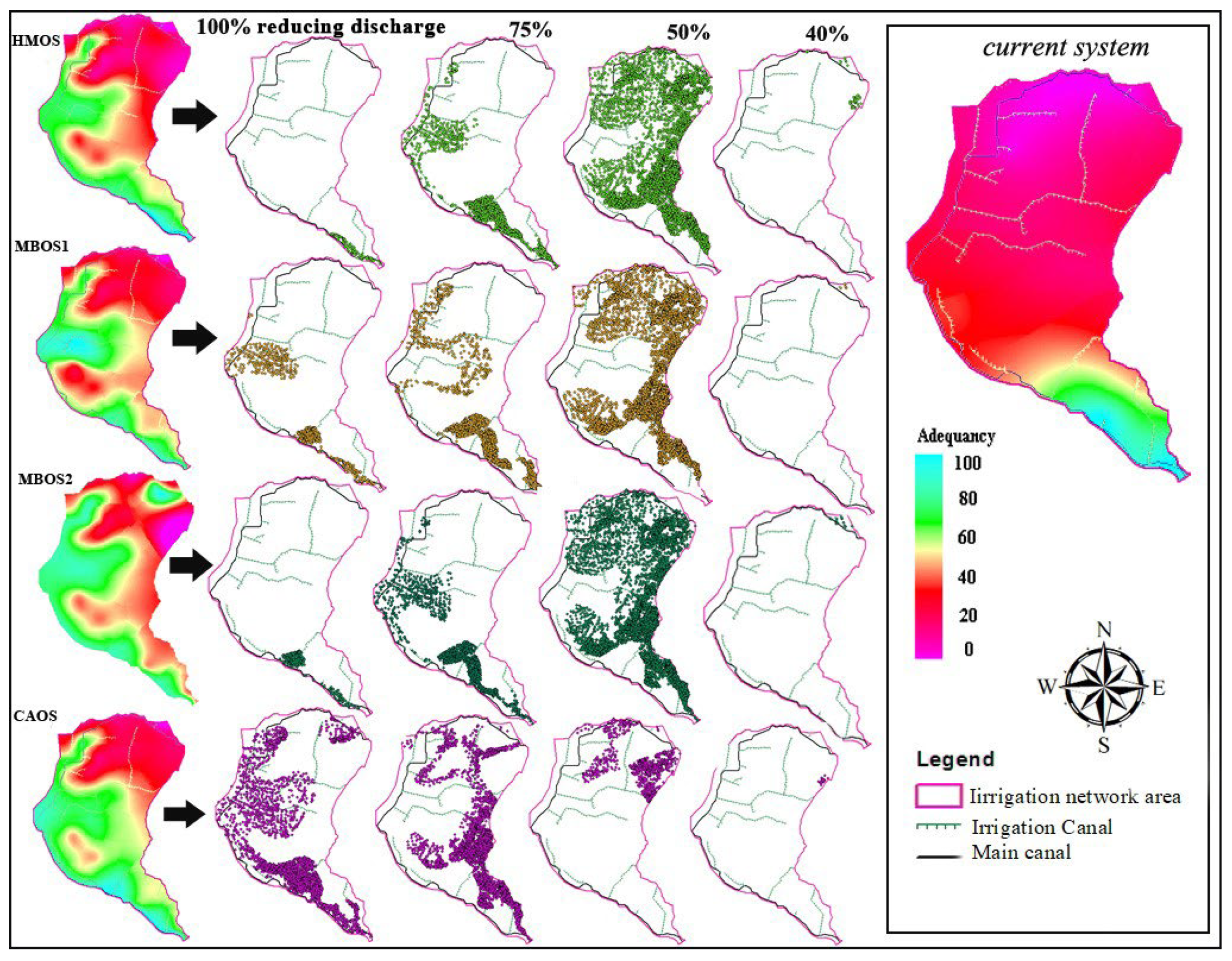
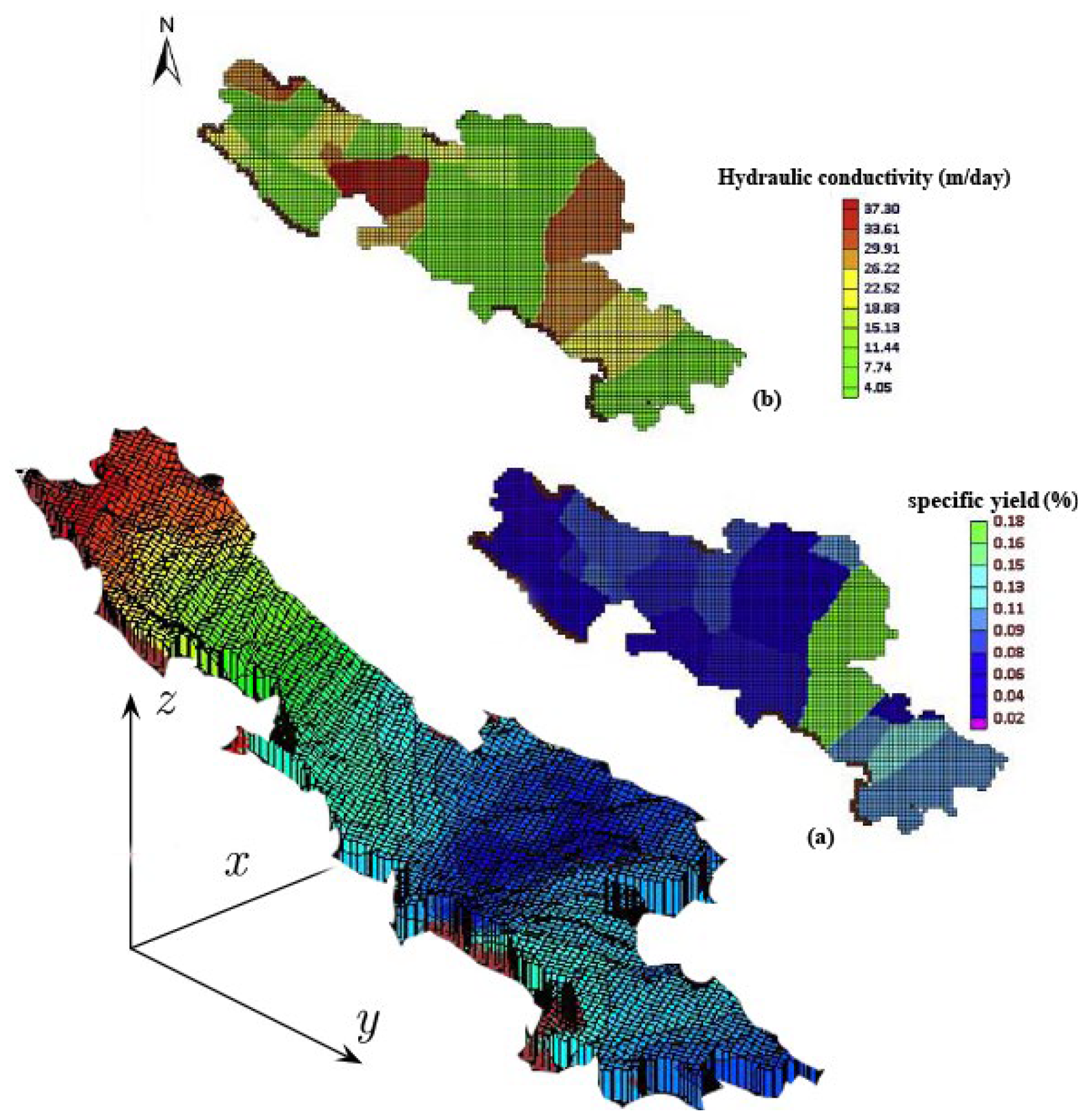
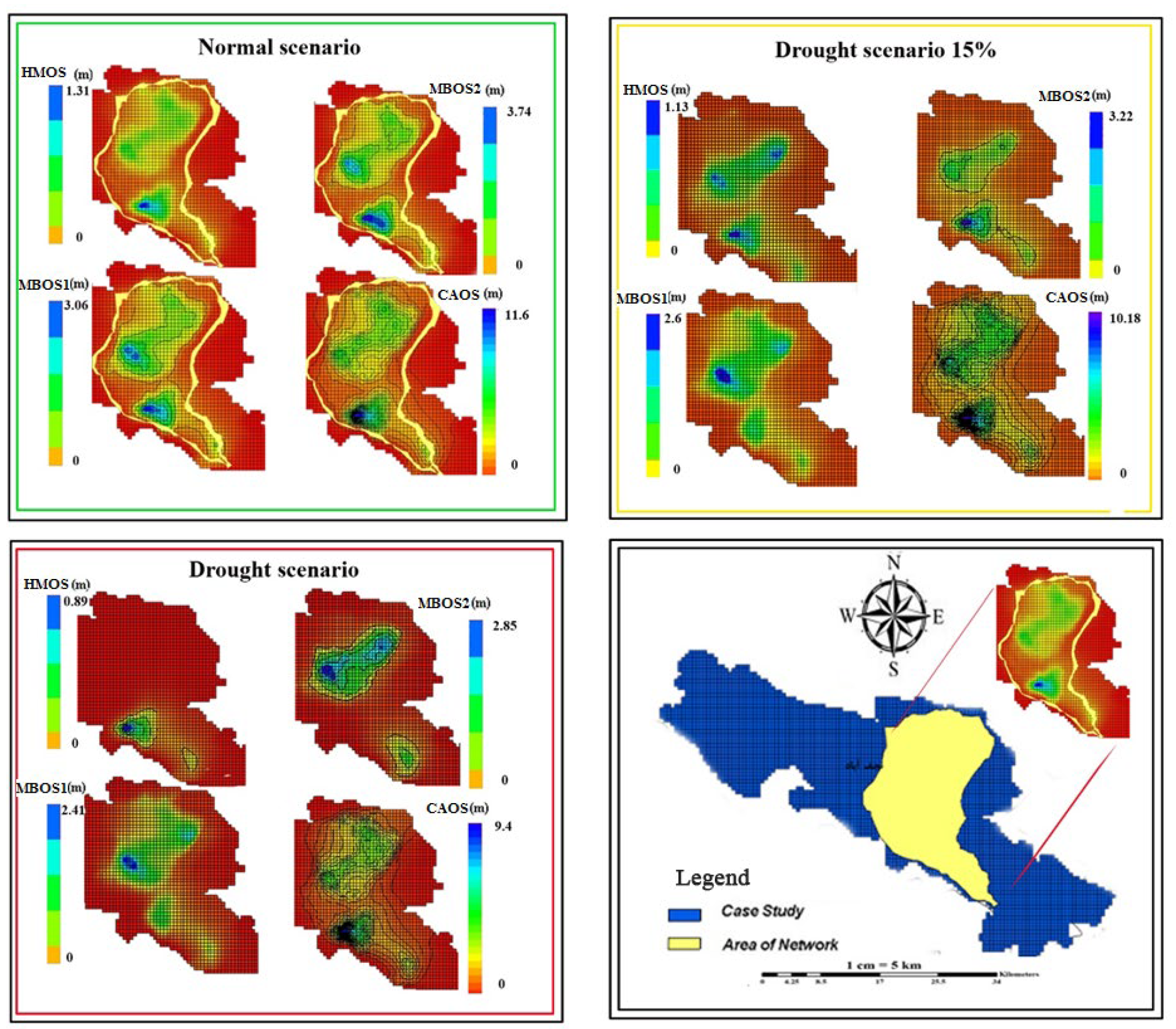

| Index | Performance Class | ||
|---|---|---|---|
| Good | Mediocre | Poor | |
| 0.9–1 | 0.8–0.89 | <0.8 | |
| 0–0.1 | 0.11–0.20 | >0.2 | |
| Aquifer Balancing Strategy | Adequacy Index | Dependability Index | ||||
|---|---|---|---|---|---|---|
| Good | Fair | Poor | Good | Fair | Poor | |
| HMOS 1 | 2 | 4 | 7 | 1 | 4 | 8 |
| MBOS 2A | 2 | 5 | 6 | 2 | 4 | 7 |
| MBOS B | 4 | 6 | 3 | 4 | 3 | 6 |
| CAOS 3 | 13 | 0 | 0 | 13 | 0 | 0 |
| Current system | 0 | 3 | 10 | 0 | 1 | 12 |
| Aquifer Balancing Strategy | Being Closed | Number of Operational Wells | ||
|---|---|---|---|---|
| 75% | 50% | 40% | ||
| HMOS | 88 | 1240 | 5830 | 44 |
| MBOS A | 289 | 1233 | 5664 | 16 |
| MBOS B | 627 | 1521 | 5050 | 4 |
| CAOS | 2494 | 3701 | 990 | 17 |
| Aquifer Balancing Strategy | Adequacy Index | Dependability Index | ||||
|---|---|---|---|---|---|---|
| Good | Fair | Poor | Good | Fair | Poor | |
| HMOS | 2 | 2 | 9 | 1 | 4 | 8 |
| MBOS A | 1 | 3 | 9 | 1 | 3 | 9 |
| MBOS B | 3 | 3 | 7 | 3 | 1 | 9 |
| CAOS | 0 | 13 | 0 | 13 | 0 | 0 |
| Current system | 0 | 1 | 12 | 0 | 2 | 11 |
| Aquifer Balancing Strategy | Adequacy Index | Dependability Index | ||||
|---|---|---|---|---|---|---|
| Good | Fair | Poor | Good | Fair | Poor | |
| HMOS | 0 | 3 | 10 | 0 | 4 | 9 |
| MBOS A | 0 | 2 | 11 | 0 | 4 | 9 |
| MBOS B | 0 | 5 | 8 | 0 | 5 | 8 |
| CAOS | 0 | 13 | 0 | 13 | 0 | 0 |
| Current system | 0 | 0 | 13 | 0 | 3 | 10 |
Publisher’s Note: MDPI stays neutral with regard to jurisdictional claims in published maps and institutional affiliations. |
© 2022 by the authors. Licensee MDPI, Basel, Switzerland. This article is an open access article distributed under the terms and conditions of the Creative Commons Attribution (CC BY) license (https://creativecommons.org/licenses/by/4.0/).
Share and Cite
Tork, H.; Javadi, S.; Hashemy Shahdany, S.M.; Berndtsson, R.; Ghordoyee Milan, S. Groundwater Extraction Reduction within an Irrigation District by Enhancing the Surface Water Distribution. Water 2022, 14, 1610. https://doi.org/10.3390/w14101610
Tork H, Javadi S, Hashemy Shahdany SM, Berndtsson R, Ghordoyee Milan S. Groundwater Extraction Reduction within an Irrigation District by Enhancing the Surface Water Distribution. Water. 2022; 14(10):1610. https://doi.org/10.3390/w14101610
Chicago/Turabian StyleTork, Hamed, Saman Javadi, Seyed Mehdy Hashemy Shahdany, Ronny Berndtsson, and Sami Ghordoyee Milan. 2022. "Groundwater Extraction Reduction within an Irrigation District by Enhancing the Surface Water Distribution" Water 14, no. 10: 1610. https://doi.org/10.3390/w14101610
APA StyleTork, H., Javadi, S., Hashemy Shahdany, S. M., Berndtsson, R., & Ghordoyee Milan, S. (2022). Groundwater Extraction Reduction within an Irrigation District by Enhancing the Surface Water Distribution. Water, 14(10), 1610. https://doi.org/10.3390/w14101610









